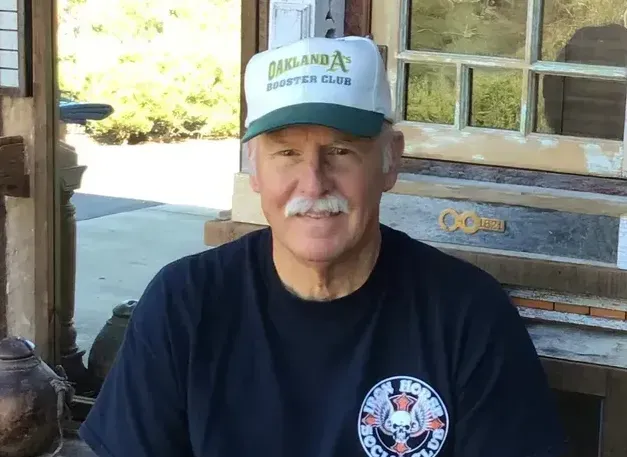Born and raised in San Leandro, California, Jim subsequently received his BS degree from BYU in 1971. After a five year stint with the California Angels Baseball Club, Jim worked as a police officer and fireman for the Sunnyvale Department of Public Safety in California for nearly twenty-nine years before retiring in Placerville, California. Having no formal art training, Jim began his art career by creating daVinci type airplanes and helicopters from metal, then graduating to elaborate old western town wall scenes, and mining town scenes on large pieces of driftwood. During this same period, Jim began collecting a few architectural items and a small amount of barn wood, which led him to creating a display cabinet. The cabinet caught the eyes of a friend who commissioned him to make a small night stand. Having no idea what he would use for legs, he happened upon some claw foot bathtub legs in the gold country town of Murphy’s California. The legs were a perfect touch and the hunt was now on for further items. The results inspired him to acquire copious amounts of barn wood as well as architectural elements, and create what you see today. Travels through hundreds of antique stores, flea markets, salvage yards, and, yes, auto salvage yards, on both coasts, Mexico, Canada, and New Zealand have resulted in the acquisition of assorted finials, pulls, locks, tins, cast iron elements, hinges, raised door panels, and heater vents.
Combining the two elements have allowed Jim to create truly one-of-a kind tables, wine cabinets, display cases, and pedestals that won’t be found anywhere else. No piece can be duplicated due to the ravages of weather, misuse over time, paint peeling, rust, or the non-existence of an already used element.
Finding the architectural elements is an enjoyable task, but finding, acquiring, and preparing the wood is an arduous one. It has to be removed from the structure, in the heat of summer or the cold of winter, while at the same time dealing with dirt, nails, insects, and spider webs. The wood is then de-nailed and its rotted portions are cut off. Once home, it has to be fine cut, rechecked for nails, planed on one side in most cases, cleared of dirt, then the splits must be glued back together.
The design of each creation is usually dictated by the architectural element he chooses, but may change as the work progresses. Sometimes he has a design in mind, then chooses the element that will most enhance the piece. Each creation is glued, nailed, and biscuit jointed for strength. Pains are taken to ensure that no rust, weathered paint, moss, or weathered portions of wood are disturbed. At times, fresh cuts are veneered from weathered strips retained during the salvage process. Sharp edges are hammered to give the effect of aging. Paint is applied to some fresh cuts when veneering isn’t practical. Old nails are applied to the face frame (front) so as to give the appearance that the piece is secured in that manner.In the majority of cases original architectural elements are used. In the event a reproduction element is used, the item may be painted with a water based paint then treated with muriatic acid to give an aged look. Jim tries to recapture the past and in some ways retain it through his work. His work allows him to relive the past and hopes you can do the same. He feels it is a shame that our rich history and architecture is being bulldozed under for the sake of progress. Once the barns and other structures that man created and nature enhanced are removed from the landscape, they are gone forever, never to be duplicated. Enjoy, and thank you for your interest.
—JIm Engelhardt

